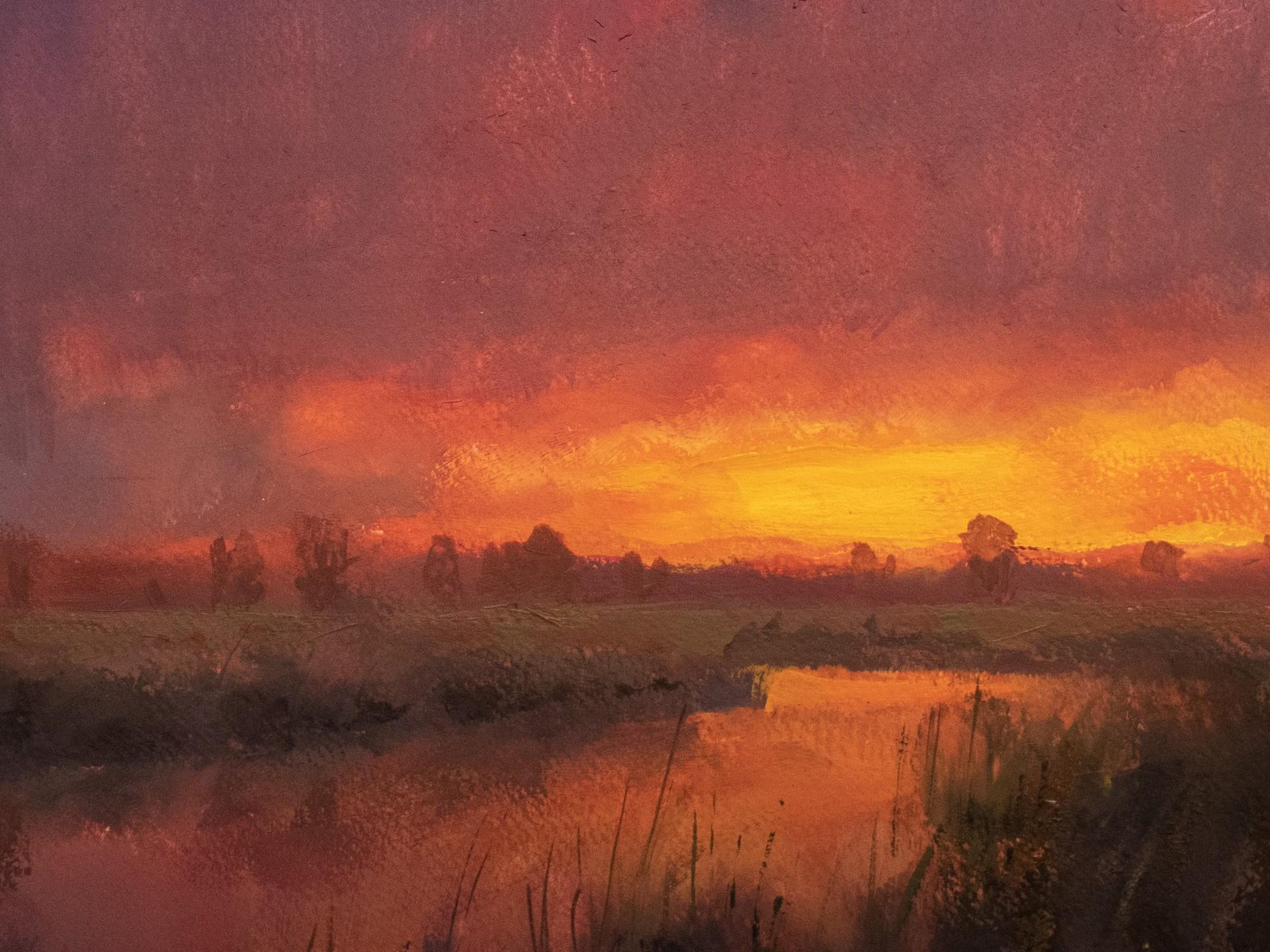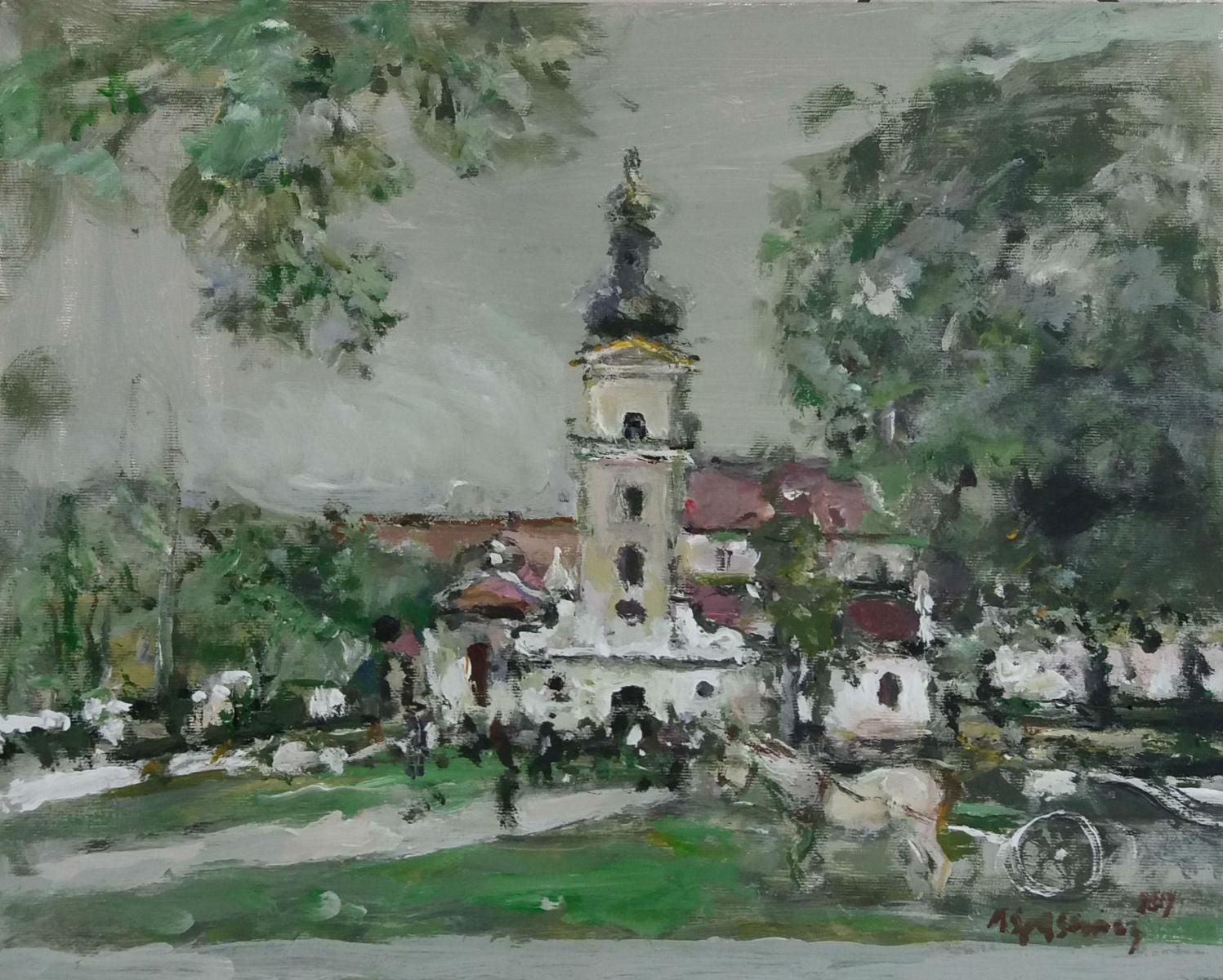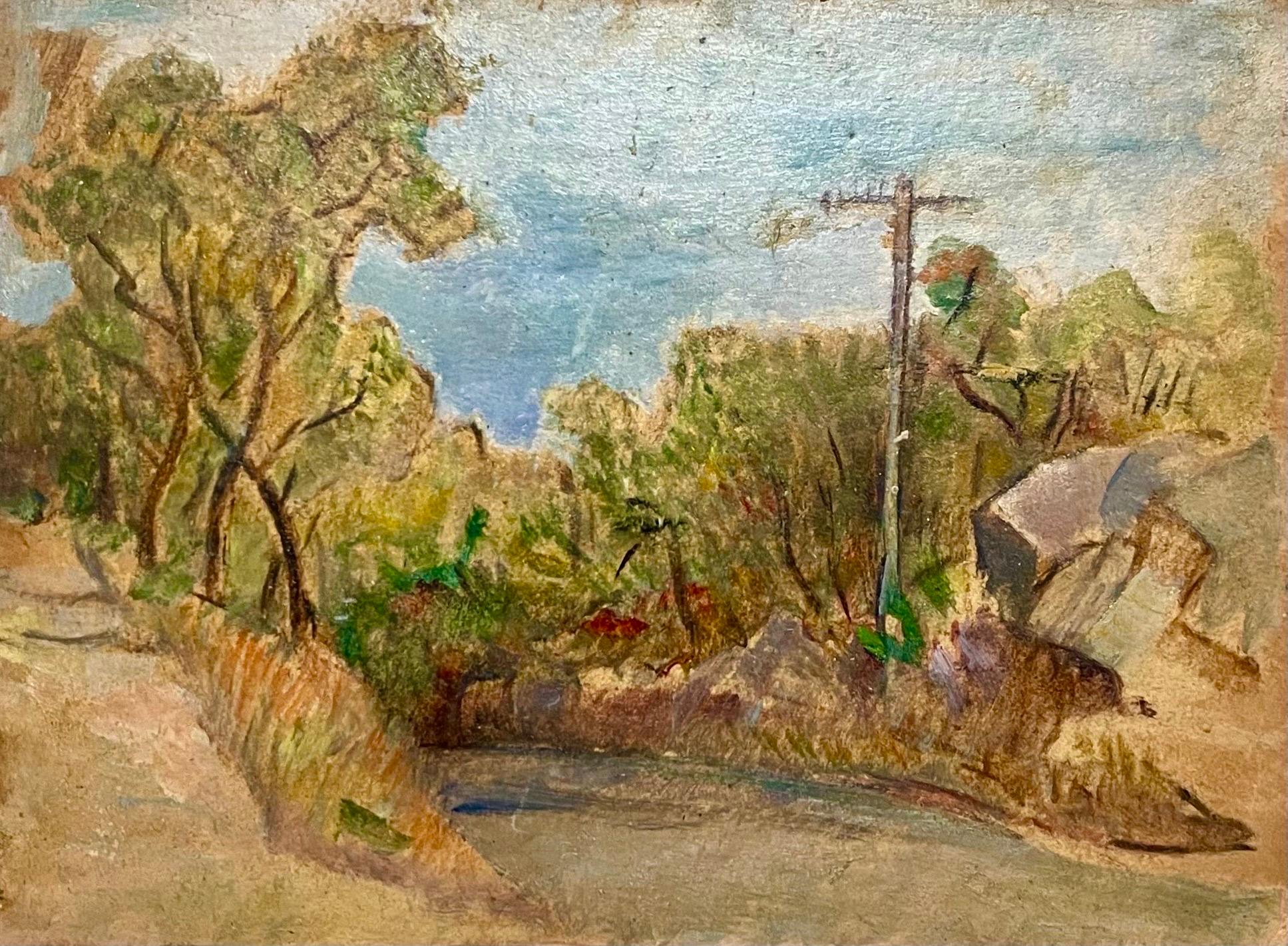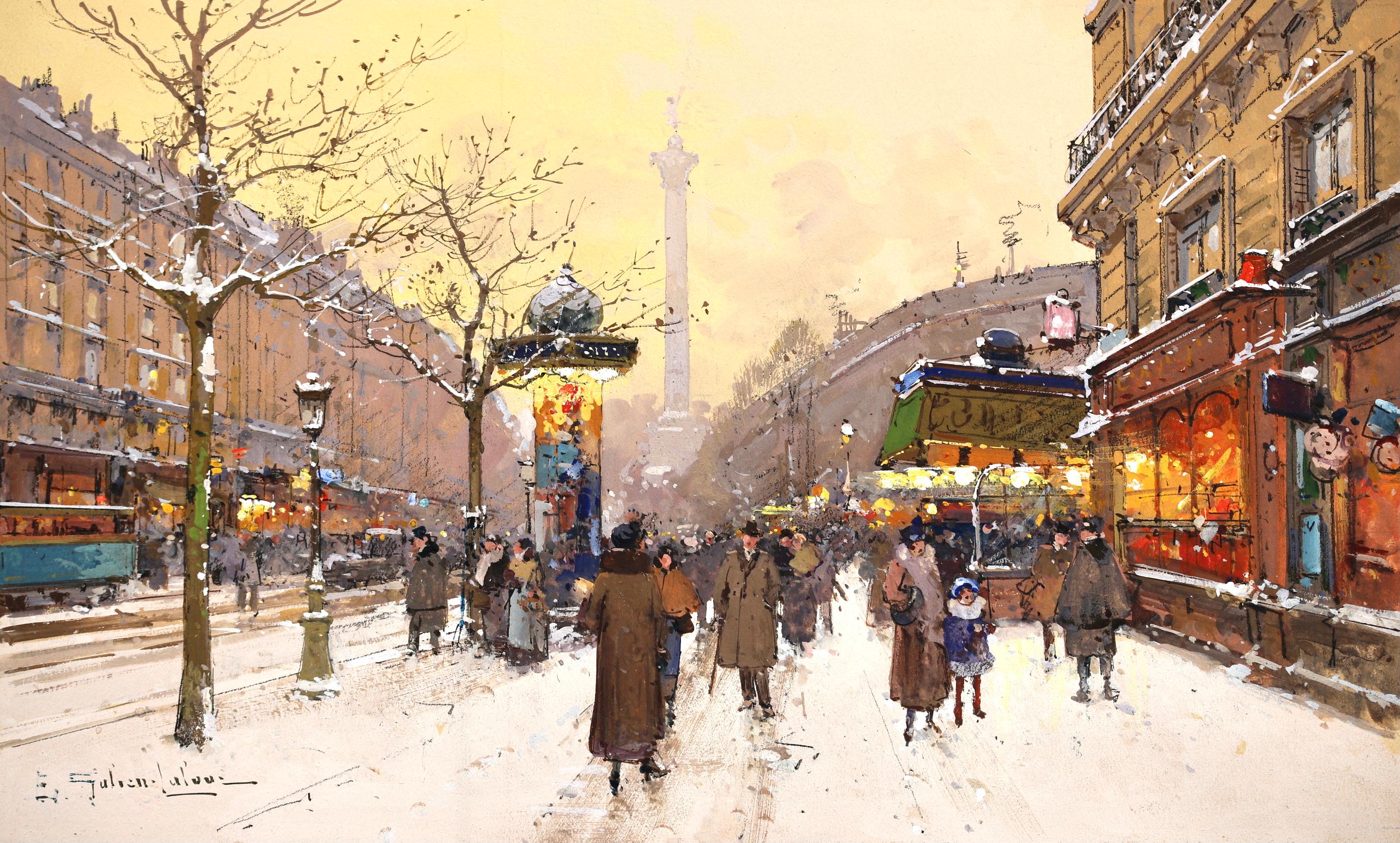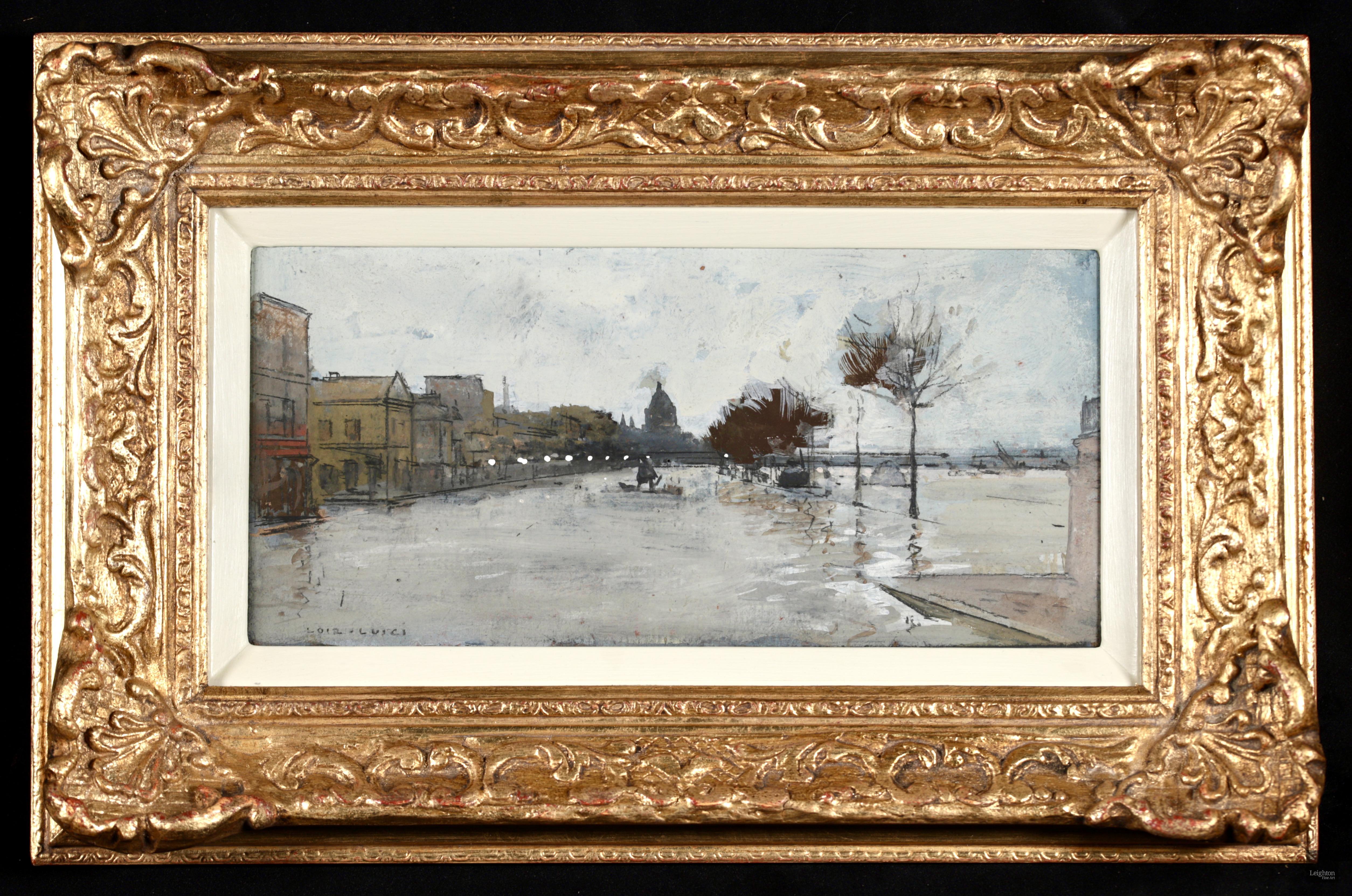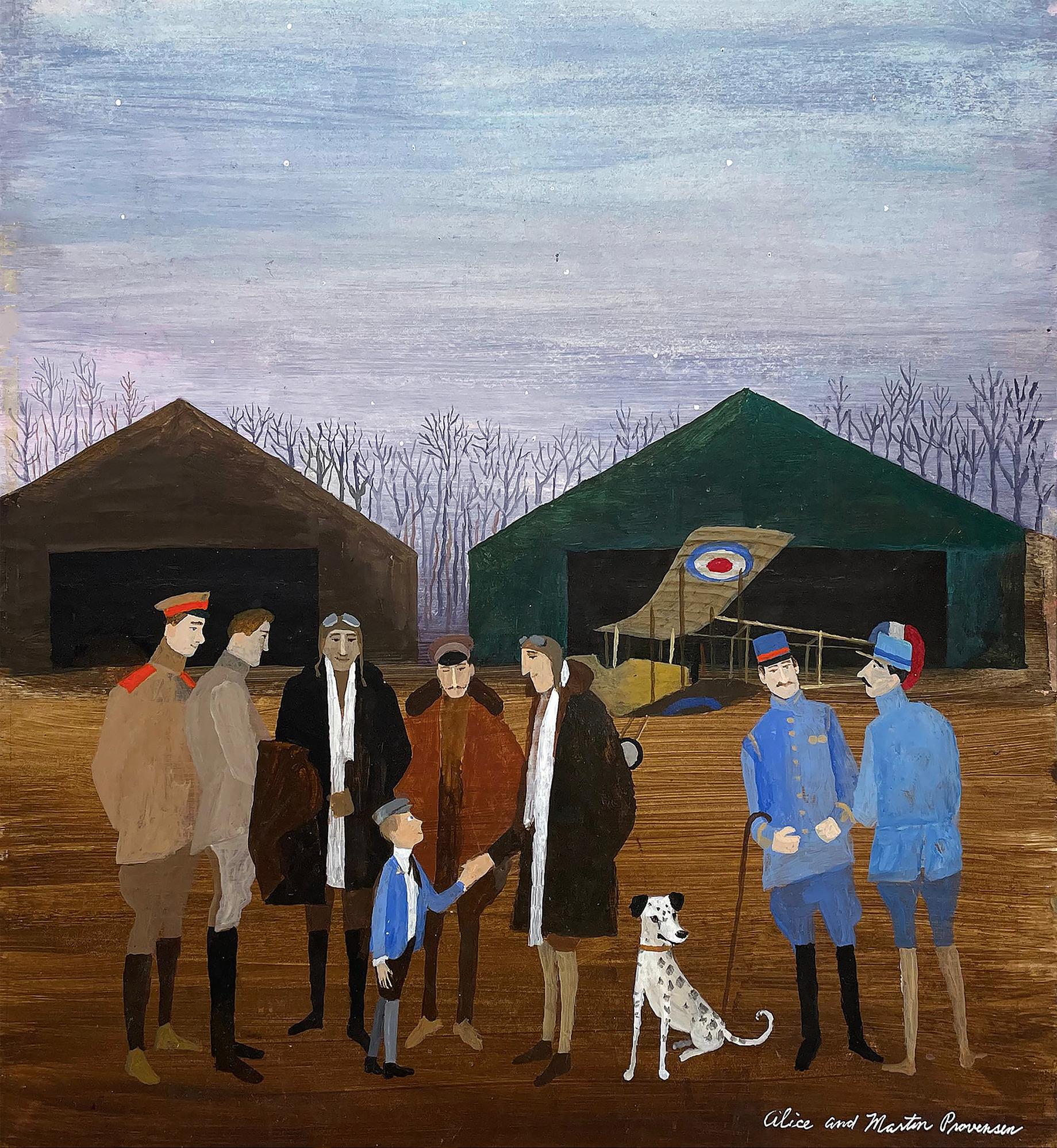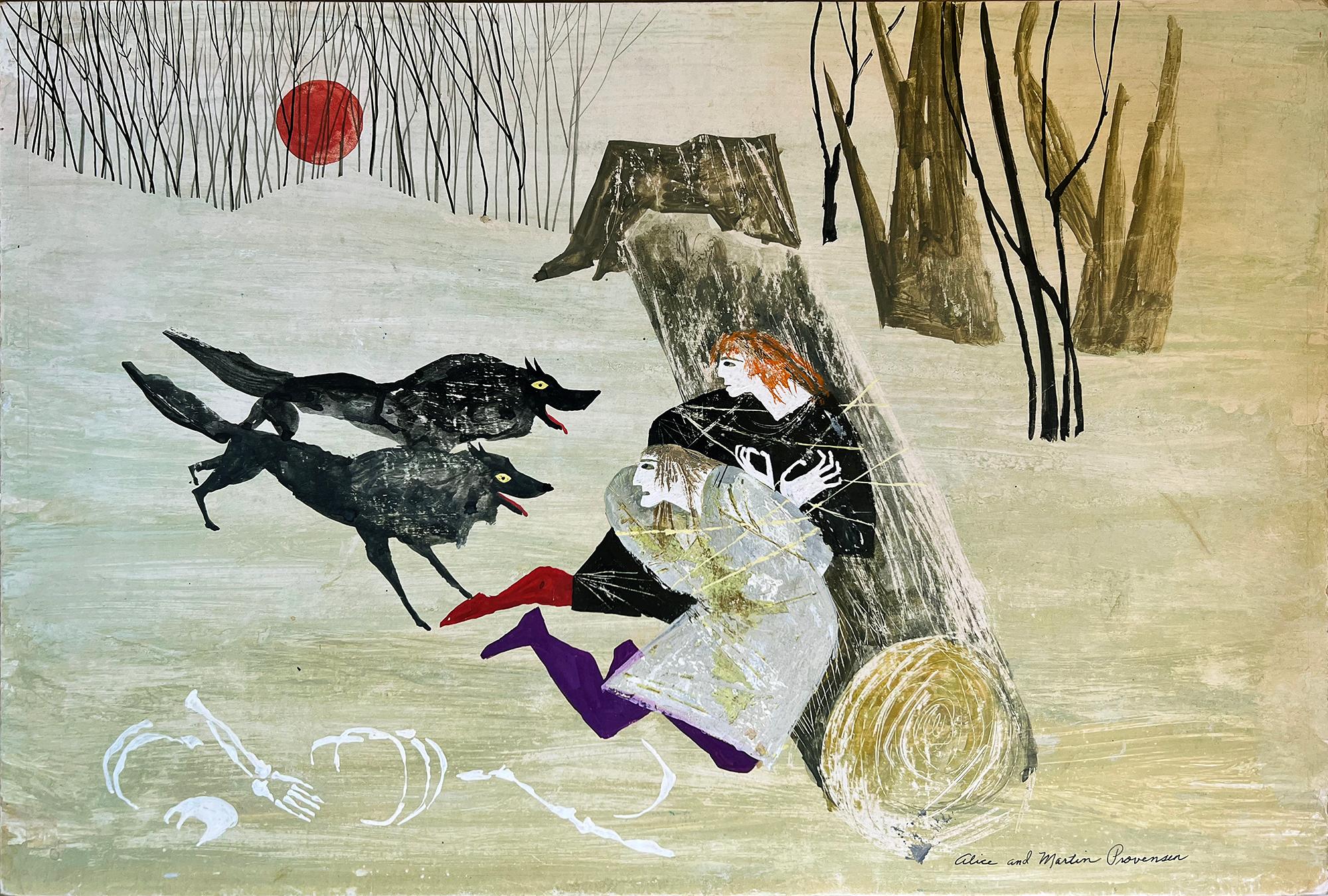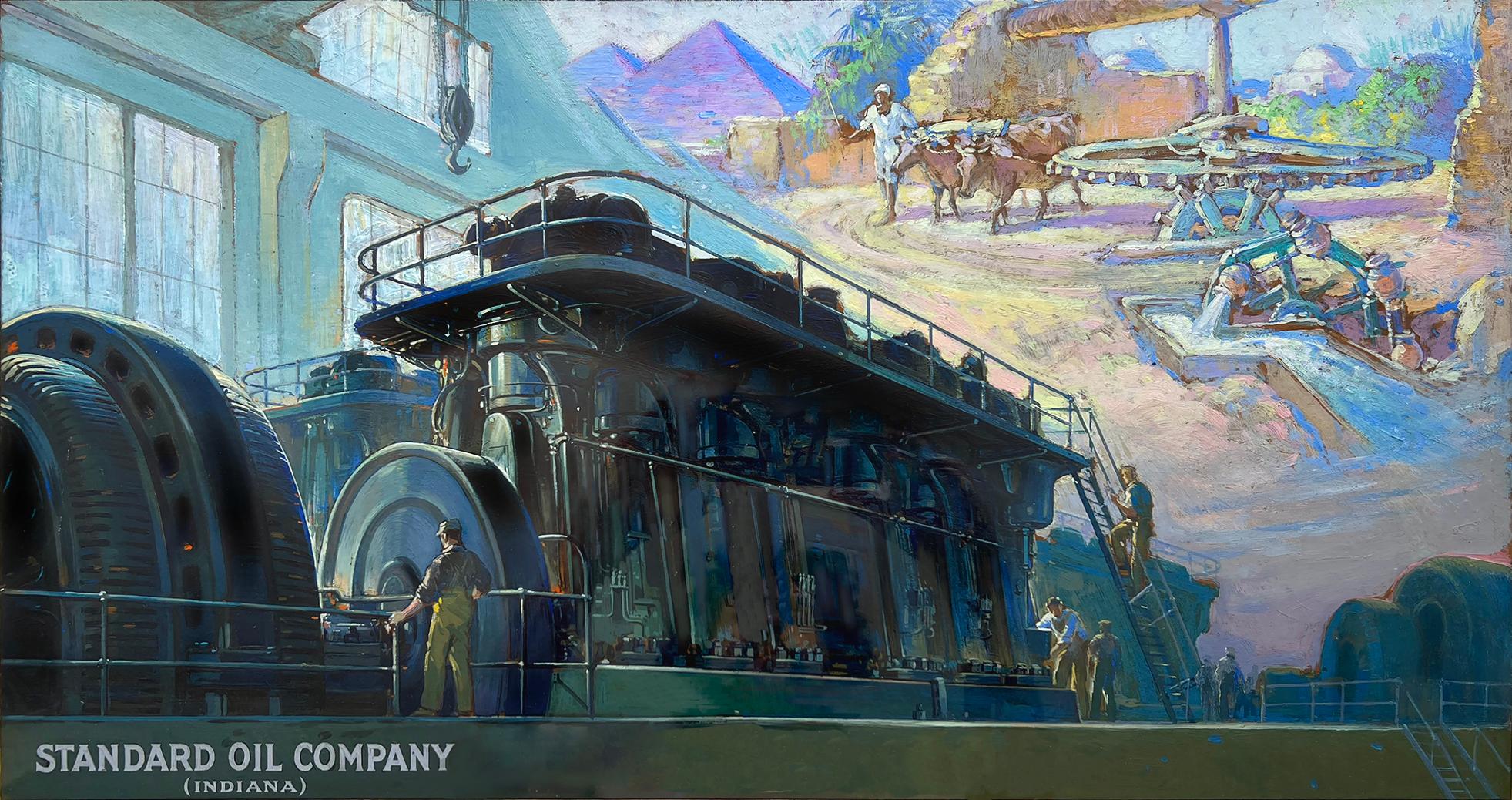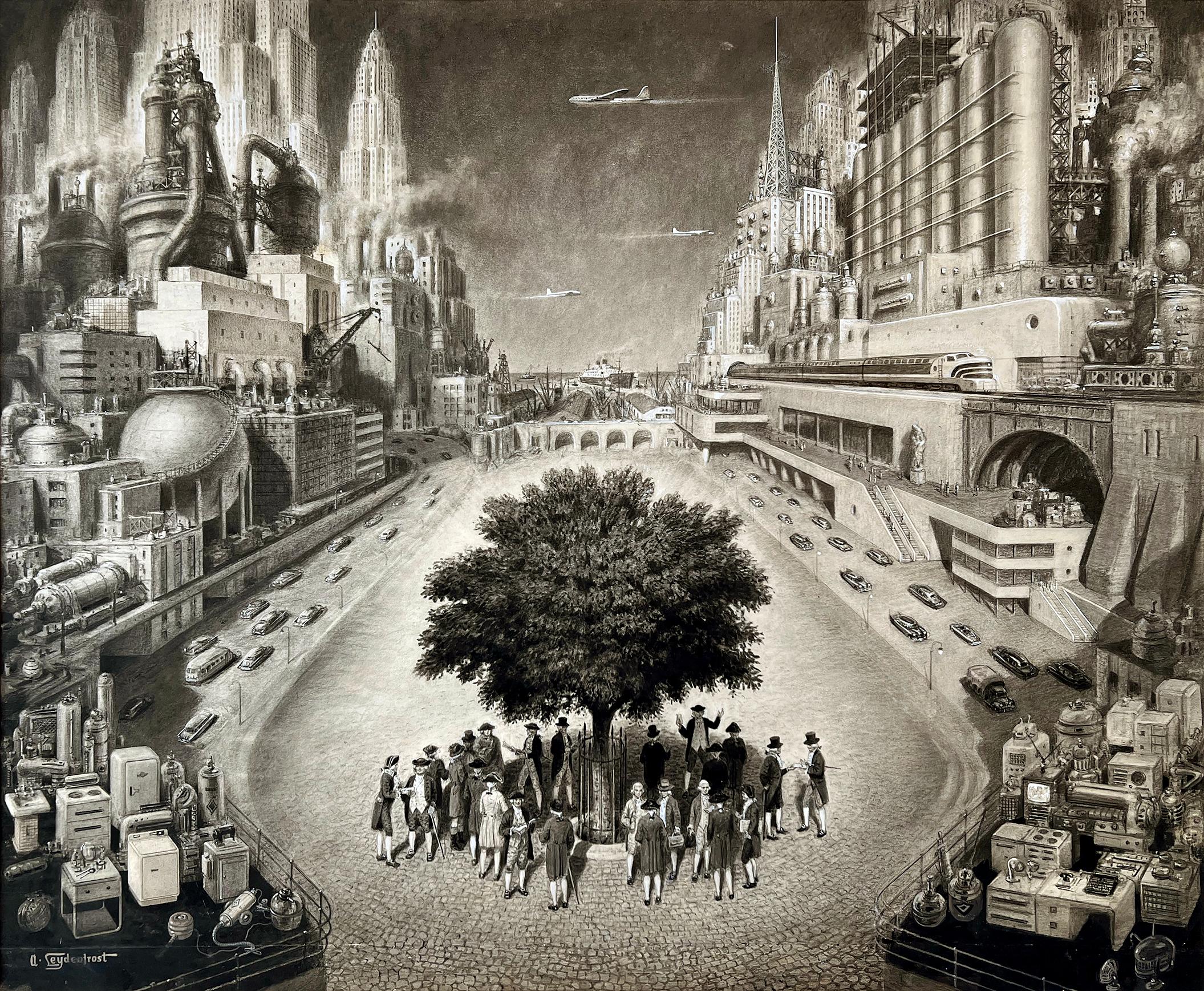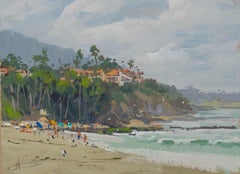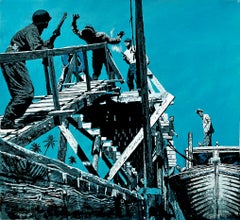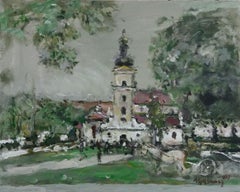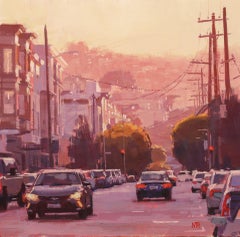
"A Summer Afternoon in San Francisco, " original gouache watercolor painting
View Similar Items
Want more images or videos?
Request additional images or videos from the seller
1 of 3
Nate Ross"A Summer Afternoon in San Francisco, " original gouache watercolor painting2021
2021
About the Item
- Creator:Nate Ross
- Creation Year:2021
- Dimensions:Height: 8 in (20.32 cm)Width: 8 in (20.32 cm)
- More Editions & Sizes:Edition of 1Price: $700
- Medium:
- Period:
- Condition:
- Gallery Location:Denver, CO
- Reference Number:Seller: 31stmini1stDibs: LU130829414112
About the Seller
5.0
Platinum Seller
These expertly vetted sellers are 1stDibs' most experienced sellers and are rated highest by our customers.
Established in 1990
1stDibs seller since 2019
524 sales on 1stDibs
Typical response time: 1 hour
More From This SellerView All
- Last LightLocated in Denver, CODevin Michael Robert's "Last Light" is an original, handmade oil painting that depicts a rendering of a landscape.Category
21st Century and Contemporary Figurative Paintings
MaterialsIllustration Board, Gouache
$520 Sale Price20% Off - "Treasure Island Beach, " Gouache paintingBy Judd MercerLocated in Denver, COJudd Mercer's (US based) "Treasure Island Beach," is an original, handmade oil painting that depicts blue waves crashing on the shore of a sandy beach filled with people. About the Artist: Judd Mercer is a watercolor painter based in Denver, Colorado. After attending art school for industrial design, Judd pursued a career in digital design and user experience and is co-owner of Elevated Third, a Denver-based digital agency. After committing to writing and illustrating a full-length fantasy novel in his spare time, Judd began watercolor painting around 2014, studying with teachers such as Alvaro Castagnet, Joseph Zbukvic and Herman Pekel...Category
2010s American Impressionist Landscape Paintings
MaterialsGouache
- "Inspiration Point, " Gouache paintingBy Judd MercerLocated in Denver, COJudd Mercer's (US based) "Inspiration Point," is an original, handmade oil painting that depicts blue waves crashing on the coast of a rocky shore. About the Artist: Judd Mercer is a watercolor painter based in Denver, Colorado. After attending art school for industrial design, Judd pursued a career in digital design and user experience and is co-owner of Elevated Third, a Denver-based digital agency. After committing to writing and illustrating a full-length fantasy novel in his spare time, Judd began watercolor painting around 2014, studying with teachers such as Alvaro Castagnet, Joseph Zbukvic and Herman Pekel...Category
2010s American Impressionist Landscape Paintings
MaterialsGouache
- "Foothills in Shadow, " Gouache PaintingBy Judd MercerLocated in Denver, COJudd Mercer's (US based) "Foothills in Shadow," is an original, handmade gouache painting that depicts a yellow grassy valley as it intersects with snow du...Category
2010s Impressionist Landscape Paintings
MaterialsGouache
- "Telluride in Fall, " Gouache PaintingBy Judd MercerLocated in Denver, COJudd Mercer's (US based) "Telluride in Fall" is an original, handmade gouache painting that depicts a flowing stream cutting through a landscape of trees with their fall plumage of y...Category
2010s Impressionist Landscape Paintings
MaterialsGouache
- "Spring Magic" Gouache PaintingBy Judd MercerLocated in Denver, COJudd Mercer's (US based) "Spring Magic" is an gouache painting that depicts the tilted landscape of a hill covered with trees and young saplings all dusted with the snow of a past wi...Category
2010s Impressionist Landscape Paintings
MaterialsGouache
You May Also Like
- Late 19th Century Original English Landscape of a Cottage in CambriaLocated in Soquel, CALate 19th Century Original English Landscape of a Cottage in Cambria Wonderful original antique painting of a thatched cottage in Cambria by Thomas Noelsmith (English, 1840-1900), c...Category
1880s Impressionist Figurative Paintings
MaterialsGouache, Illustration Board
- Pulp Magazine Marine Combat Scene Shoot Out in Blue NoirLocated in Miami, FLWhat makes this work important? It's not that it's a commissioned artwork for a men's 60s pulp adventure magazine depicting the instant a soldier is shot. The big point of the painting is how brilliantly the formal elements are thought out, designed, and executed. John McDermott tells a story using a complex figural composition in an unexpected wide-angle vision. The work is as abstract as it is representation. His use of light is significant because it creates a high-contrast two-color style that bears the mark of its creator. This is a work done by a master artist/illustrator without peers compared to artists living today. If the contemporary art world gave awards for draftsmanship, painting technique, and graphic design .... John McDermott would win the highest accolades. Initialed lower left - unframed John McDermott (August 30, 1919 – April 20, 1977), also known under the pen names J.M. Ryan and Mariner, was an American illustrator and author noted for action and adventure illustrations.[1] McDermott worked as an in-between and effects animator for Walt Disney Studios and as a US Marine combat artist,before establishing himself as a cover illustrator for 1950s paperbacks and pulp magazines such as Argosy, American Weekly, and Outdoor Life. Under his J.M. Ryan pen name, he wrote the novels The Rat Factory (1971), a derogatory satire of Walt Disney and the Disney studio; Brooks Wilson Ltd (1967), on which the 1970 film Loving was based; and Mother's Day (1969) about Ma Barker. Under his own name, he novelized director-writer Bo Widerberg's screenplay for the 1971 film Joe Hill, which would be his final published book. Early life John Richard McDermott was born 30 August 1919 in Pueblo, Colorado, the younger of two sons of Henry McDermott, an oil broker. McDermott was a young child when his father committed suicide.[4] The family eventually moved to Los Angeles where McDermott's mother, Hazel, worked in a beauty parlor. He graduated from Hollywood High School in 1936. Although he had had no formal art education, he took a job as an artist at Walt Disney Animation Studios. Career Disney At Disney, McDermott worked as an in-betweener and effects animator on Brave Little Tailor, Pinocchio, The Reluctant Dragon and Fantasia. His experiences while working at Disney, particularly during the time of the 1941 Disney animators' strike, would later become the basis for his 1969 satirical novel The Rat Factory. McDermott left Disney to fight with US forces during World War II. US Marines McDermott World War II sketch titled "Buddy is Wounded" On September 29, 1942, McDermott enlisted with the US Marine Corps. He served as a "pistol and palette" combat artist assigned to the map-making section. As a sergeant with the III Amphibious Corps, McDermott was involved in battles in the South Pacific theater of war, documenting the Guam, Okinawa and the Guadalcanal Campaigns. McDermott considered his wartime years to be his art education. "In the Marines, as a combat artist, I traveled with the troops and for three years got all the drawing opportunity anyone could want. My work changed enormously during this time and I’m sure it was due to constant drawing, every single day, from life, just putting down what I saw around me. In a few instances it was a dangerous kind of scholarship." According to the Marine Corps history journal Fortitudine, McDermott was so prolific that his contemporary style pen-and-ink sketches became easily recognizable to both Marines, from published work in Leatherneck Magazine, and civilians, from glossy copies supplied by the Marine Corps to the nation's press.His wartime art appears in World War II history books and is displayed at the Pentagon and the National Museum of the Marine Corps. Illustration Following the end of World War II, McDermott moved from California to New York City to work as a freelance illustrator. McDermott made his reputation drawing modern action, war and adventure scenes. His work adorned the covers and inside story pages of popular pulp magazines of the 1950s such as Argosy, Adventure, Blue Book, Outdoor Life and American Weekly. McDermott's illustrations appeared on numerous covers of 1950s paperback novels published by Dell, Fawcett Gold Medal, Bantam Mystery and others. His action graphics were geared toward thriller and detective genres, such as Donald Hamilton's Matt Helm books Murderers' Row and The Betrayers. He also created covers for science fiction comic titles such as Voyage to the Deep[citation needed] and horror-themed paperbacks such as the classic 1955 science fiction novel The Body Snatchers...Category
1960s American Realist Figurative Paintings
MaterialsIllustration Board, Gouache
- Zamość - XXI century, Gouache on cardboard, Figurative, LandscapeBy Magdalena SpasowiczLocated in Warsaw, PLMAGDALENA SPASOWICZ Studied painting under prof. Jan Cybis and graphic arts with prof. Tadeusz Kulisiewicz at the Academy of Fine Arts in Warsaw. She received her diploma in 1953. He...Category
21st Century and Contemporary Other Art Style Landscape Paintings
MaterialsGouache, Cardboard
- Simka Simkhovitch WPA Artist Oil Painting Gouache American Modernist PowerlineBy Simka SimkhovitchLocated in Surfside, FLSimka Simkhovitch (Russian/American 1893 - 1949) This came with a small grouping from the artist's family, some were hand signed some were not. These were studies for larger paintings. Simka Simkhovitch (Симха Файбусович Симхович) (aka Simka Faibusovich Simkhovich) (Novozybkov, Russia May 21, 1885 O.S./June 2, 1885 N.S.—Greenwich, Connecticut February 25, 1949) was a Ukrainian-Russian Jewish artist and immigrant to the United States. He painted theater scenery in his early career and then had several showings in galleries in New York City. Winning Works Progress Administration (WPA) commissions in the 1930s, he completed murals for the post offices in Jackson, Mississippi and Beaufort, North Carolina. His works are in the permanent collections of the Dallas Museum of Art, the National Museum of American Art and the Whitney Museum of American Art. Born outside Kyiv (Petrograd Ukraine) into a Jewish family who owned a small department store. During a severe case of measles when he was seven, Simcha Simchovitch sketched the views outside his window and decided to become an artist, over his father's objections. Beginning in 1905, he studied at the Grekov Odessa Art School and upon completion of his studies in 1911 received a recommendation to be admitted to the Imperial Academy of Arts. Though he enrolled to begin classes in architecture, painting, and sculpture at the Imperial Academy, he was dropped from the school roster in December because of the quota on the number of Jewish students and drafted into the army. Simchovitch served as a private in the 175th Infantry Regiment Baturyn [ru] until his demobilization in 1912. Re-enrolling in the Imperial Academy, he audited classes. Simka Simkhovitch exhibited paintings and sculptures in 1918 as part of an exhibition of Jewish artists and in 1919 placed 1st in the competition "The Great Russian Revolution" with a painting called "Russian Revolution" which was hung in the State Museum of Revolution. In 1922, Simkha Simkhovitch exhibited at the International Book Fair in Florence (Italian: Fiera Internazionale del Libro di Firenze). In 1924, Simkhovitch came to the United States to make illustrations for Soviet textbooks and decided to immigrate instead. Initially he supported himself by doing commercial art and a few portrait commissions. In 1927, he was hired to paint a screen for a scene in the play "The Command to Love" by Fritz Gottwald and Rudolph Lothar which was playing at the Longacre Theatre on Broadway. Art dealers began clamoring for the screen and Simkhovitch began a career as a screen painter for the theater. Catching the attention of the screenwriter, Ernest Pascal, he worked as an illustrator for Pascal, who then introduced him to gallery owner, Marie Sterner. Simkhovitch's works appeared at the Marie Sterner Gallery beginning with a 1927 exhibit and were repeated the following year. Simkhovitch had an exhibit in 1929 at Sterner's on circus paintings. In 1931, he held a showing of works at the Helen Hackett Gallery, in New York City and later that same year he was one of the featured artists of a special exhibit in San Francisco at the California Palace of the Legion of Honor in Lincoln Park. The exhibit was coordinated by Marie Sterner and included four watercolors, including one titled "Nudes". He is of the generation of Russian Soviet artists such as Isaac Pailes, Serge Charchoune, Marc Chagall, Chana Orloff, Isaac Ilyich Levitan, and Ossip Zadkine. In 1936, Simkhovitch was selected to complete the mural for the WPA Post office project in Jackson, Mississippi. The mural was hung in the post office and courthouse in 1938 depicted a plantation theme. Painted on the wall behind the judge’s bench, “Pursuits of Life in Mississippi”, a depiction of black workers engaged in manual labor amid scenes of white professionals and socialites, was eventually covered over in later years during renovations due to its stereotypical African American imagery. Simka painted what he thought was typical of Jackson. His impression of pre-civil rights Mississippi was evidently Greek Revival column houses, weeping willow trees, working class families, and the oppression of African Americans. He painted African American men picking cotton, while a white man took account of the harvest and a white judge advised a white family, calling it Pursuits of Life in Mississippi. Though clearly endorsed by the government and initially generally well-received, the mural soon raised concerns with locals as the climate toward racial segregation began to change. The main concern was whether depictions that show African Americans in subjugated societal roles should be featured in a courtroom. The following year, his painting "Holiday" won praise at an exhibition in Lincoln, Nebraska. In 1940, Simkhovitch's second WPA post office project was completed when four murals, "The Cape Lookout Lighthouse and the Orville W. Mail Boat", "The Wreck of the Crissie Wright", "Sand Ponies" and "Canada Geese" were installed in Beaufort, North Carolina. The works were commissioned in 1938 and did not generate the controversy that the Jackson mural had. The main mural is "The Wreck of the Crissie Wright" and depicts a shipwreck which had occurred in Beaufort in 1866. "The Cape Lookout Lighthouse and the Orville W. Mail Boat" depicted the lighthouse built in 1859 and the mail boat that was running mail during the time which Simkhovitch was there. The boat ran mail for the area until 1957. "Sand Ponies" shows the wild horses common to the North Carolina barrier islands and "Canada Geese" showed the importance of hunting and fishing in the area. All four murals were restored in the 1990s by Elisabeth Speight, daughter of two other WPA muralists, Francis Speight...Category
1930s American Modern Landscape Paintings
MaterialsGouache, Oil, Board
- Place de la Bastille - Impressionist Snowy Cityscape by Eugene Galien-LaloueBy Eugene Galien-LaloueLocated in Marlow, BuckinghamshireSigned impressionist gouache on board circa 1890 by sought after French painter Eugene Galien-Laloue. The piece depicts a depicting a bustling city scene at the Place de Bastille in ...Category
1890s Impressionist Figurative Paintings
MaterialsBoard, Gouache
- The Great Flood of Paris - Impressionist Landscape Gouache Painting - Luigi LoirBy Luigi LoirLocated in Marlow, BuckinghamshireSigned gouache on board impressionist landscape by French painter Luigi Loir. This work depicts the famous flood of Paris in 1910 when the Seine broke its banks in the largest flooding the city had seen in a 100 years. Loir likely painted this work "en plein air" as he encountered this rare natural occurrence. Signature: Signed lower left Dimensions: Framed: 13"x19" Unframed: 5"x11" Provenance: Private French collection He first exhibited at the Paris Salon in 1865 with a Landscape at Villiers-sur-Seine which brought him a certain amount of recognition. He was a regular exhibitor at the Salon des Artistes Français. Obtaining a third-place medal in 1879, and a second-place medal and a gold medal in 1889 at the Exposition Universelle in Paris. He was decorated with the Légion d'Honneur in 1898. Born in Austria to French parents who served the exiled French Bourbon royal family, Luigi Aloys-François-Joseph Loir moved with his family and the Bourbons to the Duchy of Parma in 1847. In 1860 his family returned to Paris following the expulsion of the Bourbons from Parma. But Luigi remained in the city, having enrolled, at the young age of eight, at the Accademia de Belle Arti. He eventually rejoined his family in Paris in 1863. There he studied with the decorative painter and set designer Jean Pastelot, making his Salon debut in 1865. Loir painted mainly views of Paris, in all seasons and at different times of the day or night. Loir was the Paris painter...Category
Early 20th Century Impressionist Landscape Paintings
MaterialsGouache, Board


